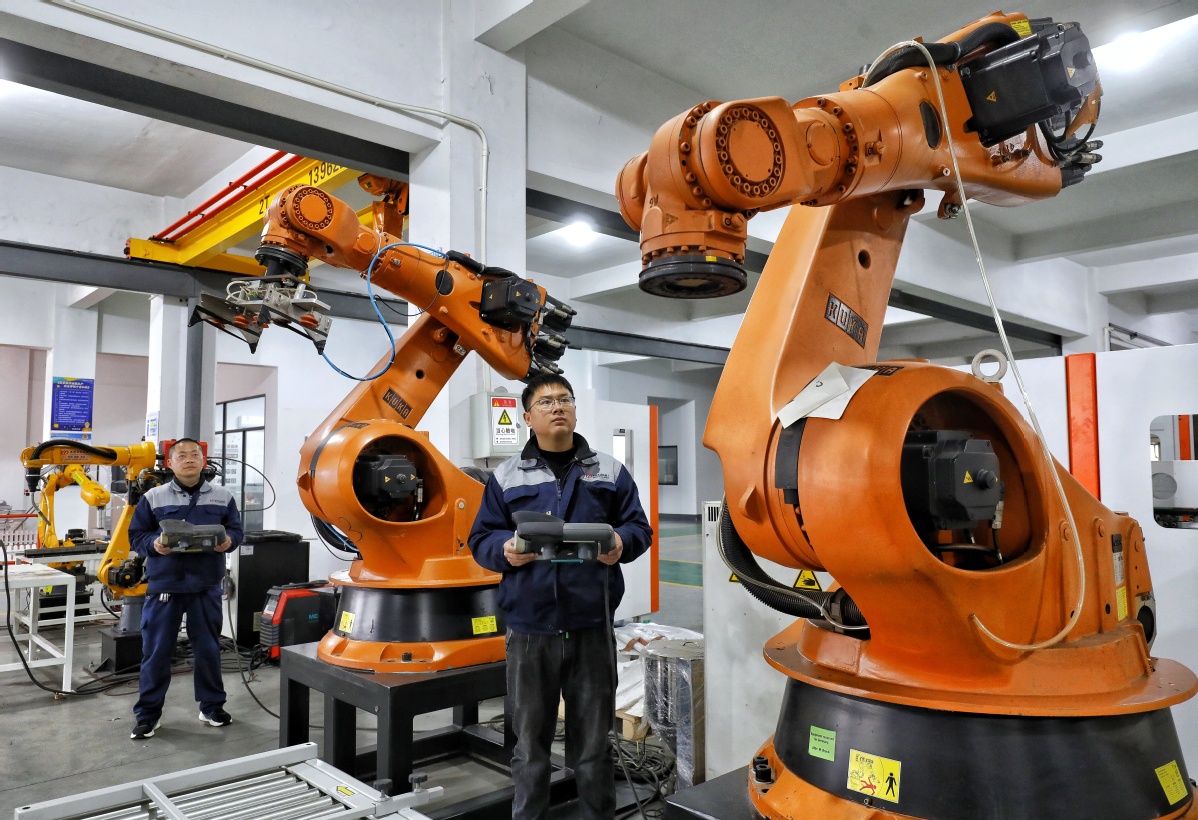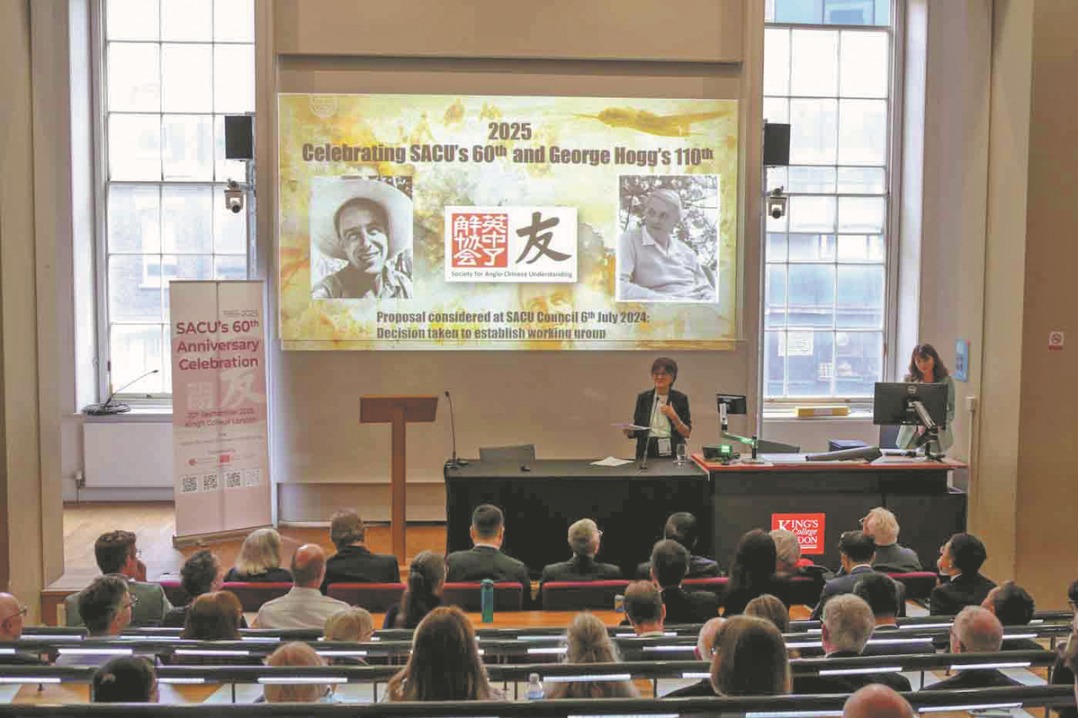China on track for sustained growth






China's development is supported by a range of favorable conditions that outweigh unfavorable factors. The country's economic recovery is on an upward trajectory, and the long-term trend of high-quality development remains intact.
With strategic opportunities arising from the new technological revolution, a robust industrial foundation, a vast market, and comprehensive support across various factors, China is well-positioned for sustained progress and economic growth.
Analyzing the trends of labor, capital, and total factor productivity — key determinants of economic output — from a production function perspective reveals that China has the potential to achieve a sustained economic growth rate of around 4.5 percent until 2035.
In the coming years, China has the potential to leverage its population advantage, continuously improve the quality of its workforce and optimize labor allocation, with a focus on shifting toward the quality rather than the sheer quantity of its population.
China has a sizable working-age population, providing a rich pool of labor resources for economic growth. Despite experiencing a negative growth in population since 2022, China's total population remains among the largest in the world.
This vast population not only offers abundant labor resources but also generates substantial consumer demand, creating a massive market advantage and providing extensive development opportunities and multiple possibilities for economic growth.
In 2023, China's working-age population reached about 860 million people, surpassing the combined total of the United States, Europe, and Japan. Not only does China boast a massive working-age population, but it also maintains a stable and increasing number of young workers. Additionally, the country's labor participation rate is at a relatively high level on a global scale.
Despite the accelerating trend of population aging in China, the proportion of younger seniors remains relatively high. Proactive measures, such as delaying retirement, have been employed or discussed to address the challenges posed by population aging and enhance the labor force participation rate among the younger senior population.
Silver economy
Furthermore, the emergence of the silver economy, driven by an aging population, has broad scope and a long industrial chain. It is poised to provide numerous opportunities for the development of new business formats and models, potentially becoming a new growth driver for the economy.
Meanwhile, China's labor force is experiencing sustained improvements in health and education levels.
While the COVID-19 pandemic has widened health disparities across the world, with some countries experiencing a decline in key health indicators, the health of China's population has shown sustained improvement. The health conditions of Chinese residents have progressed consistently, with the average life expectancy approaching levels seen in developed countries.
In 2023, the population with higher education reached over 250 million, accounting for 17.7 percent of the total population. The average duration of education for the working-age population has steadily increased to 11.05 years.
The ongoing process of new urbanization in China is leading to a sustained optimization of labor force distribution, creating immense potential for improving the efficiency of labor resource allocation.
In 2023, China's urbanization rate reached 66.16 percent in terms of permanent urban population, indicating a noticeable gap compared with the approximately 80 percent level seen in developed countries. As the rural population migrates to urban areas and individuals from economically underdeveloped regions move to more prosperous areas, the spatial distribution of the labor force will improve significantly.
As the process of rural-to-urban migration continues in China, it is effectively unlocking the consumption and public investment potential of the migrant population. This, in turn, enhances the efficiency of labor resource allocation and fully taps into the economic potential of the rural labor force.
China's current phase of rapid development in new industrialization, informatization, urbanization, and agricultural modernization presents massive potential for capital formation and economic growth.
Opportunities in green transformation, new infrastructure construction, urban renewal, and addressing deficiencies in people's livelihoods contribute to the creation of a favorable investment environment and the realization of China's potential economic growth rate.
By capitalizing on these opportunities, China can foster sustainable and inclusive development, bringing prosperity to its people and contributing to global economic progress.
Clean energy
The demand for clean energy production and supporting facilities, driven by the green transformation of energy, presents significant growth potential for investment.
The expansion of wind and solar power generation capacity, along with the development of distributed solar photovoltaics, ultra-high voltage electricity transmission, electrochemical energy storage, hydrogen storage, and smart grid technologies, will contribute to the growth of the clean energy sector and pave the way for a sustainable and low-carbon future.
The rapid development of the digital economy is giving rise to new infrastructure demands, creating growth potential for capital formation. In the first half of 2023, investment in new infrastructure construction in China increased by 16.2 percent compared with the previous year, surpassing the growth rate of traditional infrastructure construction investments.
Furthermore, according to estimates from research institutions, China's activities in new infrastructure construction will continue to expand in future, with its share in overall infrastructure investment gradually rising to around 15 percent to 20 percent. This indicates that new infrastructure construction will provide significant growth potential for fixed capital.
Urban renewal initiatives in China, including the transformation of urban villages, the construction of underground urban infrastructure networks, and the promotion of urbanization centered around counties, present significant opportunities for capital formation.
The scale of the urban village transformation, with over 1.3 billion square meters awaiting renovation, drives substantial investments annually. Additionally, the renovation of over 100,000 kilometers of underground pipelines each year further contributes to investment opportunities.
In the foreseeable future, these urban renewal demands will effectively stimulate production activities in upstream and downstream industries, significantly supporting economic growth.
The expanding demands in livelihood sectors, such as education and elderly care, are driving the transformation and upgrade of the service industry in China and attracting more investments in various areas. The implementation of policy measures to promote the opening-up of the services industry will drive potential economic growth rates.
As China transitions into a high-quality development phase, the elevation of total factor productivity becomes increasingly important. Through deepening reforms, expanding openness, and encouraging innovation, the government aims to invigorate market entities, boost productivity, and unlock the potential for economic growth.
Against a backdrop of China's significant advantages in data resources, a high labor force population, and the accelerated growth of high-level talent, the development of data infrastructure, reforms in higher education, and measures to facilitate labor and talent mobility will be advanced to optimize resource allocation, improve productivity, and enhance total factor productivity.
China is currently facing challenges such as production overcapacity in certain sectors and limitations on traditional sector investments. To address these issues, the country is accelerating the transformation toward a service-oriented government, optimizing the structure of fiscal expenditures, and increasing subsidies to residents' incomes. These measures are aimed at enhancing consumer purchasing power and achieving a balance between supply and demand.
China recognizes the enormous potential in expanding the services industry to stimulate market vitality. To achieve this goal, the country has been continuously opening up the services industry through the establishment of free trade zones and pilot cities.
However, compared with developed economies, China's current level of openness in sectors such as finance, telecommunications, education, and healthcare remains relatively low.
China should take measures to promote the implementation of a negative list management system, relax market access, and accelerate high-standard institutional opening-up.
These initiatives are aimed at attracting more private and foreign capital into the services industry. The goal is to stimulate market vitality, promote the upgrading and transformation of the services industry, and enhance overall productivity.
China's dedication to implementing an innovation-based development strategy has resulted in a continuous enhancement of its national comprehensive innovation capabilities and cultivation of new quality productive forces.
In 2023, China ranked 12th globally in terms of overall innovation capabilities, positioning itself as a global leader in various cutting-edge industries such as quantum communication, high-speed rail, solar photovoltaics and unmanned aerial vehicles.
China has outlined its future plans to deepen reforms in the science, technology, and education sectors, aiming to enhance the country's innovation system, strengthen national strategic technological capabilities, and foster deep integration between academia, industry, and research institutions.
These measures are designed to achieve synergistic development among education, technology, and talent, effectively translating scientific and technological innovations into new quality productive forces. The objective is to drive technological progress, cultivate new formats, and nurture new drivers of economic growth.
Li Xuesong is the director of the Institute of Quantitative and Technological Economics, which is part of the Chinese Academy of Social Sciences; Zhang Huihui, Li Ying and Luo Chaoyang are researchers at the institute.




























